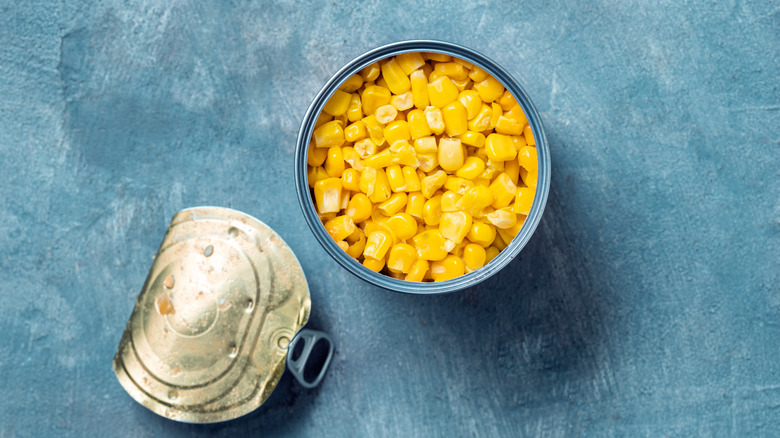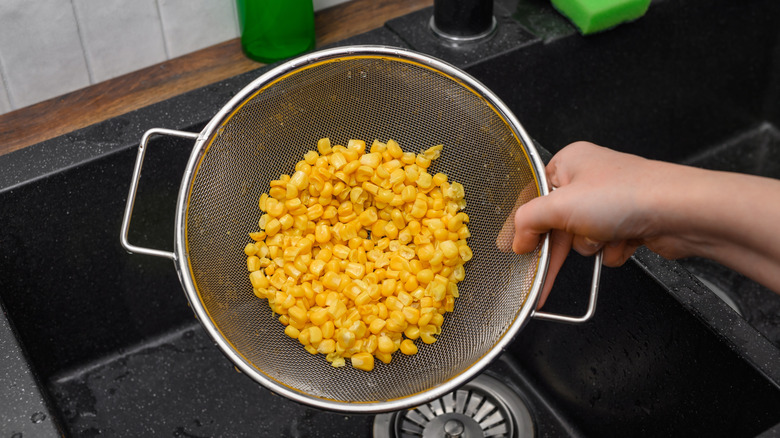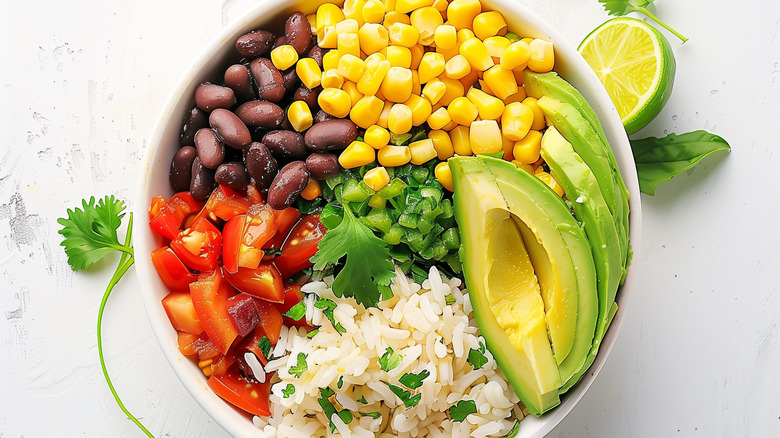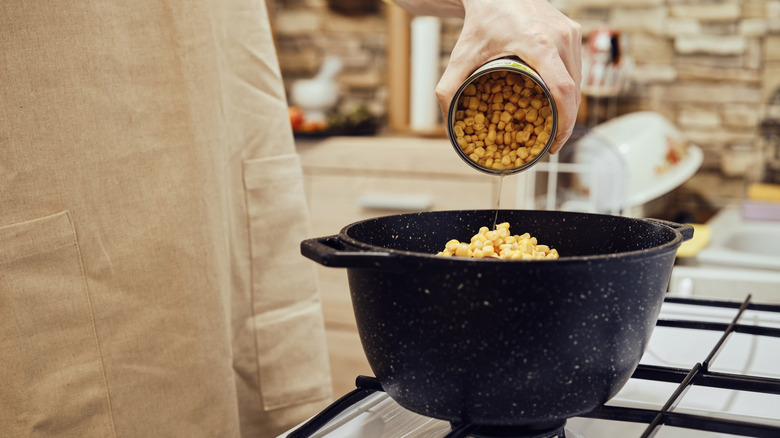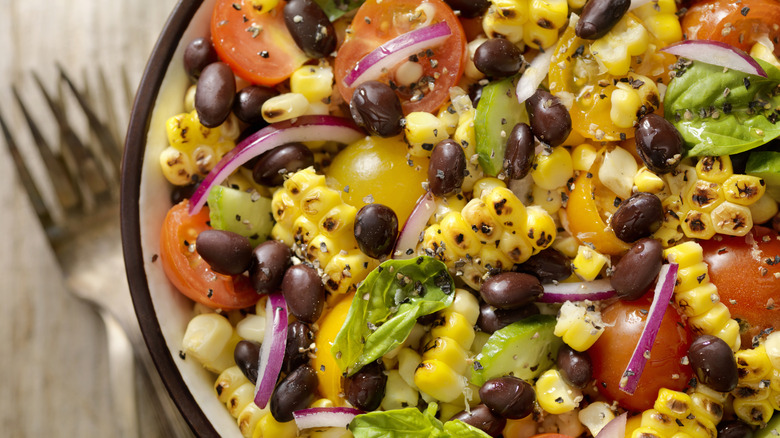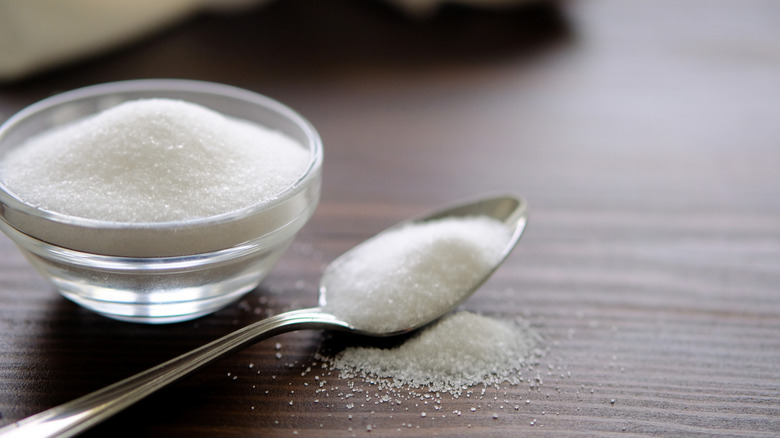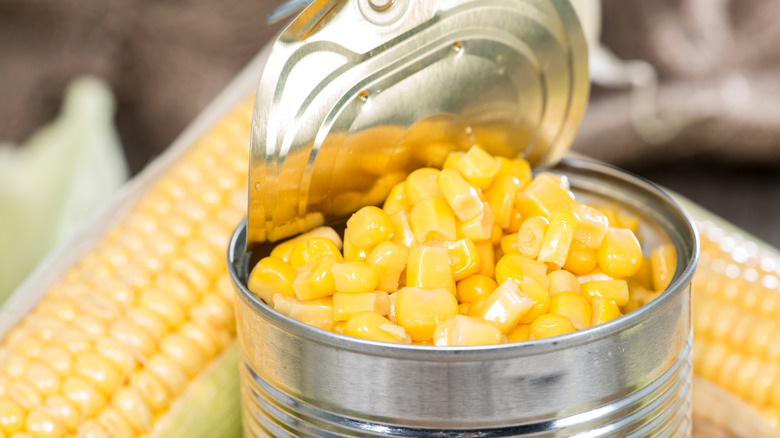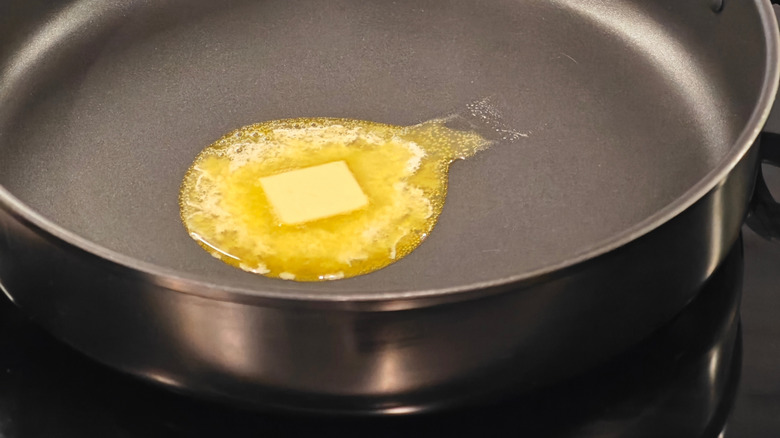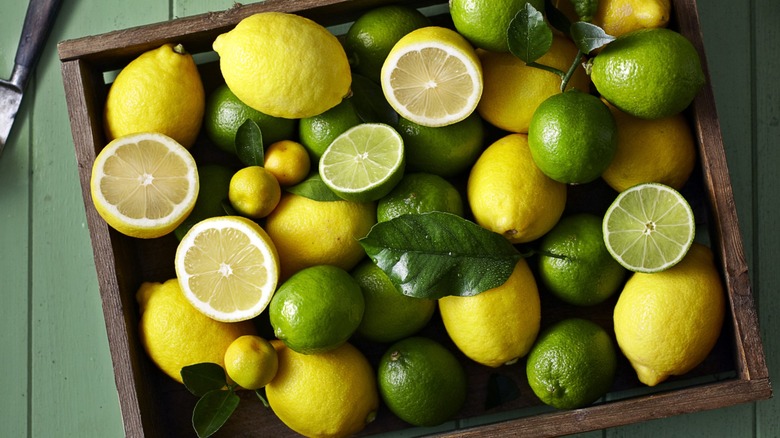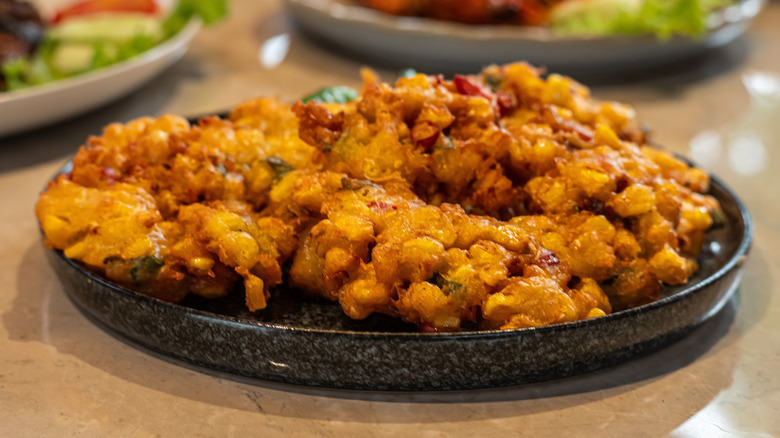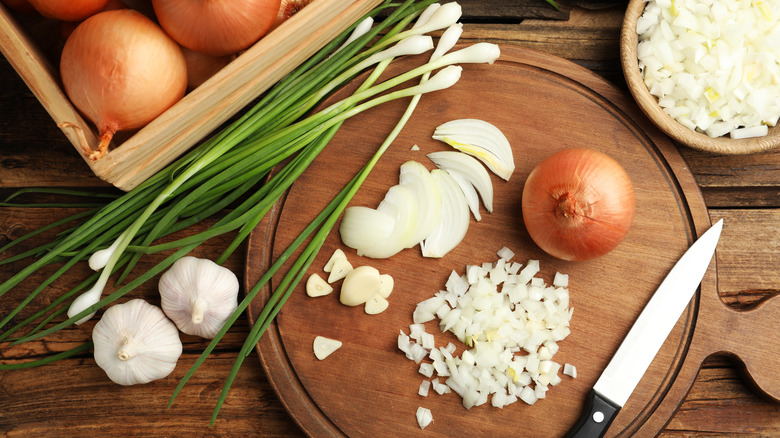Mistakes Everyone Makes With Canned Corn
Compared to the fresh flavor and crisp texture of a newly harvested cob, canned corn can seem underwhelming. It's not that it's awful, it's just ... not as good. But perhaps it's because you're guilty of some of the mistakes everyone makes with canned corn. Sure, it's never going to be the same as a fresh ear, but it can be pretty darn tasty if you treat it right.
Knowing how to cook canned corn and what to season it with makes all the difference. It doesn't have the same oomph as raw kernels, so you can't treat it as subtly. But, before you even start cooking, picking the perfect can is important, too. Not every brand is as yum as the next, so you might just have a poor example. There are so many things you can do with canned corn that it never has to be lackluster or disappointing again.
What's great about the canned stuff is that you can keep it in your pantry for years. Unlike cobs, which only keep a week or so in the fridge, canned corn is ready for you to enjoy any time. It's perfect for those quick pantry dinners — or something more elaborate — when your vegetable crisper drawer is empty. So, once you learn the common missteps people make with canned corn and how to avoid them, you've got so many delicious meals ahead of you.
Assuming all canned corn is equally good
You head to the store and pick up the first can you come across. It's corn, it makes sense to assume it's all pretty much the same. But this is your first mistake. Not all cans are created equal. Some can give fresh cobs a run for their money, while others have that unmistakable canned flavor that you just can't shake.
So, what should you do? We ranked canned corn brands from worst to best, meaning we've done the research for you, helping you learn what to avoid and what to look out for. Of course, it's not an extensive list, so you might still come across some brands we haven't covered, in which case, you'll just have to try them for yourself.
Coming in last is Kroger Sweet White Corn. It has a significant amount of added sugar, which means it isn't all that naturally sweet — and if you wanted extra sweetness, you could just add sugar yourself to taste. Our top pick was Amazon's Happy Belly Whole Kernel Sweet Corn, which has a simple ingredient list of just corn, water, and salt, and is a big hit with customers. If you're looking for something you can pick up at a grocery store, Del Monte Fresh Cut Golden Sweet Whole Kernel Corn was another of our faves.
Not rinsing it
A big flavor mistake people make with corn is not draining and rinsing it. When you want corn to taste fresh and vibrant, you need to get rid of the liquid it comes in. If you've ever noticed a distinct canned flavor, the brine is part of the problem — and it's such an easy one to fix.
Simply make sure you drain off all the liquid before you get cooking. The easiest way is to dump the whole contents of the can into a colander or sieve. This also makes it easier to rinse, which helps remove any stubborn droplets of brine and wash the unpleasant flavor down the plughole.
But the taste isn't the only reason to do this. You should always rinse canned veggies because the liquid they come in is usually salted. Canned corn can contain surprisingly high sodium levels, and rinsing helps to reduce them. It's particularly important if you're on a low-sodium diet.
Of course, you are going to want some salt for flavor, but when canned produce is already quite salty, it often leads to issues. Many people salt corn from a can as though it were fresh. This can make it overly salty, but it's hard to gauge how much salt to add, hence the problem. But when you rinse, this gives you a clean slate from which it's easier to season as normal.
Thinking it has to be cooked
One of the most common mistakes people make with canned corn is assuming it has to be cooked. It makes sense — we're used to heating things that come in a can. But when comparing canned corn and fresh corn, one of the differences is the canned stuff is already blanched before it's sealed while fresh cobs are raw. That quick heat treatment preserves the kernels and makes them ready to eat straight from the tin. So while you can cook it, you definitely don't have to.
In fact, sometimes cooking does more harm than good. Heating canned corn for too long can turn those crisp kernels soft and soggy. They lose their slight crunch, and the natural sugars that make corn so tasty can start to dull. If you're tossing it into something like soup or chili, a little simmering is fine, but if you're just heating it out of habit, you might want to rethink it.
Canned corn can be surprisingly good used straight from the can. Rinse it first to get rid of excess brine, then use it however you like. You can toss it into a salad, mix it into fresh salsa, or stir it into cold pasta salads or grain bowls — no stove required. It saves you time and effort and makes things much easier when you actively want corn that's cold or room temperature, otherwise you have to cook it and cool it, which is totally redundant.
Overcooking it
So many people end up overcooking canned corn. Maybe it's because we're used to treating it like fresh or frozen corn, or maybe it's just habit — you open the can, dump it in a pot, and let it simmer. But cooking it too long leaves it not at its best. It's among the reasons a lot of people think they're not too fond of the canned stuff.
Part of the problem is that canned corn is already cooked during processing. It's been blanched before being sealed, so it's very easy to cook it for too long. Think of it more like heating than cooking — as soon as it's warm, you can take it off the heat.
You might not think that a few minutes of extra simmering is an issue, but overcooked canned corn loses its bite. The kernels become mushy and it can't hold a candle to the fresh stuff. If you're expecting a pop or any slight crispness, you won't get that from overcooked corn. Basically, it's pretty disappointing.
If you're heating canned corn, treat it gently. A quick warm-through on the stove is all it needs. Just a few minutes, ideally over medium-low heat. No need to boil it, and definitely no long simmering sessions. If you're adding it to a dish like soup or stir-fry, consider tossing it in right at the end to preserve its texture.
Only ever simmering it
If your go-to method for heating canned corn is simmering it in a saucepan, you're not alone — but you're also missing out. While it's a quick way to warm it up, simmering doesn't do much for flavor. In fact, it can sometimes make the corn taste bland or watery. If you want canned corn at its yummiest, try roasting or sautéing it instead.
Giving corn a bit of direct heat adds depth. When you pan-fry or roast it, you get browning. And with browning comes flavor. That bit of caramelization brings out the corn's natural sweetness and gives it a rich, toasty edge that simmering just can't deliver. A hot pan with a little butter or oil, a few undisturbed minutes to let the kernels get golden, and suddenly canned corn starts tasting a whole lot more like fresh summer corn off the grill.
Roasting is another way to make it super delicious. Spread drained corn on a baking sheet, drizzle with oil, season it how you like, and roast at a high heat until it starts to brown at the edges. You might even catch a hint of that smoky, charred flavor you get from grilled corn, and all without firing up the barbecue. Cooking method makes all the difference, so make sure to experiment so you find something you love.
Leaving out the sugar
When cooking canned corn, people often assume it doesn't need any sugar. After all, corn is naturally sweet, right? Fresh corn on the cob, especially in season, is sweet, there's no doubt about that. But you can't always say the same for canned corn. The flavor can be flatter, and a little more muted, so a pinch of sugar can work wonders.
When sautéing or roasting canned corn, adding a small amount of sugar can help mimic that fresh-off-the-cob flavor. You don't want to make the dish taste sugary, but rather enhance the natural sweetness that's already there. It also plays a key role in caramelization. The sugar encourages browning, bringing out rich, toasty notes that make the corn taste deeper and more complex.
This is a particular bonus if you're trying to get that golden, slightly crisp finish that gives corn that almost grilled, street corn-like quality. Sugar helps speed up that process without needing to crank the heat or cook it for ages, which can dry it out. Just don't overdo it. You don't want dessert. Rather, you want to accentuate the sweetness that can leach out a little after months floating around in a can. That said, some brine contains sugar, as well as salt, which can lead you to over-sugaring so check the ingredients label first.
Eating it plain or minimally seasoned
Fresh corn might be delicious enough to eat with nothing but a pat of butter, but canned corn is different. One of the easiest ways to make it taste better is also one of the most overlooked: seasoning it properly. While canned corn is convenient, it lacks the same bright, fresh flavor as corn straight off the cob. That means it needs a bit more help in the seasoning department — salt and pepper alone aren't always enough. If you're chowing down on it plain or with very few seasonings, you're making a mistake.
Start with salt. Even if your corn was packed with some, once you've drained and rinsed it, you'll probably need to add more. Salt brings out the sweetness and is part of balancing the overall flavor. Then, pepper adds a mild warmth. This is the very least you can do with seasoning, but you shouldn't stop there.
It pairs well with a wide range of herbs and spices, so there are all kinds of ways you can upgrade canned corn. This is your chance to experiment. Smoked paprika, garlic powder, and cumin can add warmth and depth. A pinch of cayenne or chili powder gives it a kick. A spice blend like garam masala is also an easy way of adding a range of spices without having to mix them yourself. You could also try adding chopped cilantro, parsley, or chives — fresh herbs can elevate the whole dish.
Skipping fat when cooking it
If you're cooking canned corn without adding any fat, you're missing a big opportunity to make it tastier. Fat has a bunch of uses — it helps carry seasonings, encourages browning, and adds richness that makes the corn extra delicious. So don't be afraid to liberally throw it around the pan when you're reaching for a can of kernels.
Butter is the classic choice, and for good reason. It melts into the corn and gives it that rich, creamy flavor we tend to associate with corn on the cob. It also plays well with both sweet and savory seasonings. Butter is great with garlic, chili flakes, a touch of honey, and so much more.
Quality olive oil is another great option. It brings peppery notes and adds depth without overpowering the corn. It's perfect if you're making a dairy-free dish or want to build Mediterranean flavors. A drizzle at the end can also be a delicious addition. Then, there's toasted sesame oil, which adds a nutty, smoky edge. It's particularly tasty if you're seasoning with soy sauce, ginger, or green onions. Other flavorful oils, like chili oil or garlic-infused oil, can layer in more flavor with no extra effort.
Failing to use an acidic ingredient to balance the flavors
When something tastes flat, it's usually because the flavors are out of balance. That's especially true with canned corn. It's naturally sweet but the stuff from the can lacks complexity and nuance. If your corn tastes dull, what it likely needs is a hit of acid. However, so many folks make the mistake of going without acidic ingredients, to the detriment of the dish.
Balancing flavors is all about contrast. Sweetness, saltiness, acidity, bitterness, and umami — each element enhances the others when used in the right proportion. In the case of canned corn, you've got sweetness and maybe some salt if you've already seasoned it. But to bring everything into focus, a little acidity works wonders.
A squeeze of lime or lemon juice is a nice quick fix. Just a bit added at the end of cooking can cut through the sweetness and make the corn taste fresher and more vibrant. Vinegar works too — apple cider vinegar adds a fruity tang, while red wine or sherry vinegar brings more depth. Even a splash of white vinegar will sharpen things up without changing the flavor too much.
If you're roasting or sautéing your corn, try adding a few drops of balsamic vinegar or a spoonful of tomato paste to boost acidity with a touch of richness. Pickled ingredients — like jalapeños or red onions — also bring acid, along with their other flavors. Even chucking in some diced fresh tomatoes adds some acidic brightness.
Not mixing it into other recipes
Canned corn tends to get pigeonholed. Most people open a tin, heat it up, add some seasoning, and chuck it on the plate as a quick side dish. And, sure, there's nothing wrong with that but it is a waste of potential. Canned corn doesn't have to stand alone as a side, you can mix it into all kinds of dishes. Whether it ends up being the star or just one of many great ingredients, you should look beyond the obvious when it comes to these cans of kernels.
We've already mentioned how canned corn is great for salads and grain bowls. It also works especially well in Tex-Mex-style dishes, like black bean dips, burrito bowls, and tacos. Mix it with mayo, butter, and cotija cheese to make a quick alternative to classic esquite, a classic Mexican street food. It's also brilliant in soups and stews, giving you an easy way to add more veggies. Stir it into cornbread batter for texture and contrast. Or fold it into a frittata or savoury pancake for a quick meal that feels far more interesting than plain scrambled eggs.
It might sound odd, but canned corn also elevates sweet potatoes. You can blend it into sauces and dips. Mix it with cream cheese, spices, and chopped jalapeños for an easy hot corn dip. And let's not forget about sweetcorn fritters. The point is, corn doesn't have to go solo. Adding it to recipes can leave you with more than the sum of its parts.
Skipping onions and garlic
When you're using canned corn, it's easy to just heat it up and call it a day. But if you're skipping aromatics like onions and garlic, you're passing up a low-effort way to make your corn taste way more exciting. You don't always have to add them — sometimes you're in a rush, and fair enough. But when you've got a few extra minutes, it's totally worth it. Ignoring this option is a definite mistake.
Even just a few cloves of garlic or half an onion can level up your canned corn. Sautéed onions bring sweetness and a deeper flavor, especially if you let them soften and caramelize a little. Cook them low and slow in butter or oil until golden, and you'll get rich balances of sweet and savory that beautifully complements corn.
Then there's garlic, which is deliciously fragrant and adds a bit of pep and complexity to even a simple side dish. You can go classic with minced or sliced garlic sautéed until soft and slightly mellowed. Or you might take things up a notch with roasted garlic. Roasting softens the sharpness and brings out a sweetness that blends perfectly with corn.
Red onions, shallots, green onions — they're all fair game. You can use any of these kinds of aromatics to make your corn taste even better. Without them, it can taste a bit one-note, especially straight from the can. But with a little onion and garlic, you've suddenly got a side dish worth shouting about. It's the kind of small upgrade that makes dinner something to look forward to.
